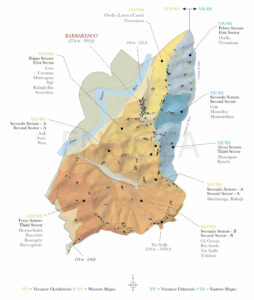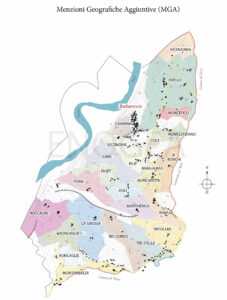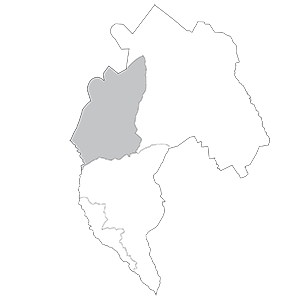Number of MGAs: 37
Number of Wineries: 41
If we look at the first map below and follow the colours, it’s clear that the municipality of Barbaresco can be divided into two parts: the Eastern Slope, which runs along the border with Neive, and the Western Slope, which looks out over the Tanaro valley. The same can be done by analyzing first background panoramic image.

1. Eastern Slope. This is the least extensive and articulated, and it can be divided into three small sectors (second image). The first, taking in most of the vineyards of the Vicenziana MGA and the eastern flank of the Ovello MGA, is quite uniform in terms of exposure and soils, even though the slightly undulating slope results in repeated oscillations in exposure between northeast, east and southeast (the last being the most favorable for Nebbiolo). The second sector is characterized by two virtually twin ridges: that of Montefico, bordering on Ovello, and that of Montestefano, both of which benefit from protected positions and full southern exposure, at least at the center. Despite the similarity between the two hills, the wines of Montefico generally stand out for finesse, while those of Montestefano show greater strength and austerity. Beyond the Cole MGA, whose wines are similar to those of Montestefano, at least in terms of substance, lies the third sector where the exposure turns once again toward the east. Unlike the wines of Ovello, characterized by full fruit and color, wines from there show more intensity and earthy touches, as often sensed in the Barbaresco of the Ronchi MGA, which occupies most of the slope (the remaining vineyards are part of the Muncagota MGA).
2. Western Slope. Excluding a few vineyards of the Vicenziana MGA and the western flank of Ovello, with the renowned areas of Casot and Loreto (see the Ovello MGA entry), the Western Slopes can also be divided into three sectors (third and fourth image). The first, with the sole exception of the Cavanna MGA, extends through a compact basin with exposures varying from full south at Secondine to west at Pajè, Rabajà-Bas and Muncagota to north at Cars, which explains why that’s the sole MGA that has never had a Barbaresco made purely from its vineyards. Moving a little further south, we come to another vineyard basin, though in this case much broader and longer, which can be divided in two parts with quite different characteristics. The first, marked with the letter ‘A’ in the above map, includes some of the most renowned MGAs of the appellation, from Asili to Rabajà and from Martinenga to Pora, without forgetting the little amphitheater of Faset. The opposite side of the valley, marked by the letter ‘B’, has as a landmark the prominent ridge of the Rio Sordo MGA, flanked by the cooler slopes of the Cà Grossa, Tre Stelle and Trifolera MGAs. To the south and west lies the third sector (fifth image), extending along an open and undulating slope with exposures varying from ideal to cooler. Starting from the Tanaro valley we come first to the Roccalini MGA, followed by Roncagliette, Roncaglie and finally Montaribaldi with vineyards bordering on the Pajorè MGA of Treiso.
As for the styles of wines, in the first sector they range from the “earthiness” of Cavanna to the warm austerity of Secondine to the sheer elegance of Pajè. In the second sector, they range from the proverbial elegance of Asili and especially of Martinenga, to the more solidly structured, and sometimes rough and mineral Rabajà, to the more reserved character of Pora and the somber tones of Faset. Structure and elegance characterize the third sector, with greater emphasis on weight at its extremes (Roccalini, Roncagliette and Montaribaldi) and a more prominent classical aspect in the case of Roncaglie.

